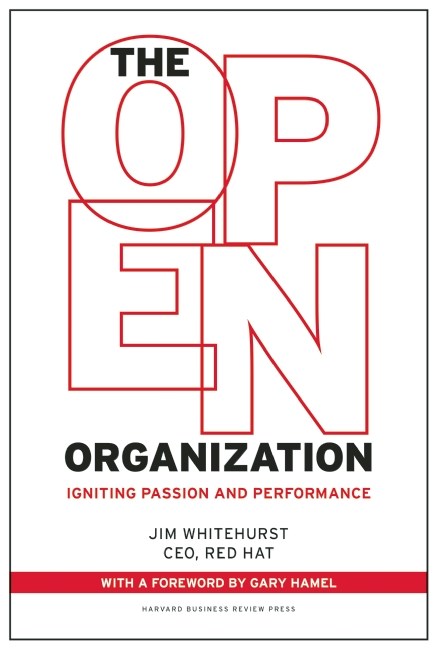The Open Organization: Igniting Passion and Performance
June 25, 2015
Red Hat's CEO Jim Whitehurst shares a manifesto for reorganizing your company.

The Open Organization: Igniting Passion and Performance by Jim Whitehurst, Harvard Business Review Press, 256 pages, $30.00, Hardcover, June 2015, ISBN 9781625275271
When companies shake up their corporate hierarchies, the business world takes notice. Last year Zappos’ Tony Hsieh earned such notice by “flattening” Zappos and instituting a Holacracy. Plenty of other companies have either originated outside the zone of traditional corporate structure or have made the decision to move to the flatter, more open structure. Not all non-traditional companies are structured the same, but that perfectly justifies the move away from traditional corporate hierarchy: no two companies are the same, and so it makes perfect sense that each company should find a structure that best ensures the company’s success. Companies like Zappos cannot achieve the kind of success they want via layers of C-suite, so they’ve reorganized. In his foreward to Jim Whitehurst’s The Open Organization, thinker Gary Hamel succinctly explains the search for new structure:
You can’t command initiative, creativity, or passion. These human capabilities are, quite literally, gifts. [...] As a leader, how do you create an environment that inspires people to volunteer these “gifts”?
Using Whitehurst’s experience at the notoriously open-source software company Red Hat, The Open Organization seeks to answer Hamel’s urgent question. Now more than ever, companies need innovation and creativity in order see continued success, but as Jim Whitehurst says:
The conventional approach to business management was not designed to foster innovation, address the needs and expectations of the current workforce that demands more jobs, or operate at the accelerated speed of business.
If you have worked in an organization governed by what Whitehurst calls “the conventional approach”, you probably know that even small requests, improvements, or projects can take weeks or months before they even begin to see progress toward completion. Among dozens of other inhibitors to innovation, the simple process of “sending something ‘up the chain’” can introduce enough time and resistance to deflate the momentum of those “on the ground” whose creativity and passion are required to make a project a success.
Whitehurst’s anecdotes about Red Hat’s structure and success strongly suggest a causal relationship between the “open” nature of Red Hat and the innovative agility the organization enjoys alongside its $10 billion estimated valuation. With The Open Organization, Whitehurst is extending the very spirit of the open organizational structure and giving any company willing to spend $30 on the book the guiding principles for achieving the same kinds of success that Red Hat has seen. Granted, changing your organizational structure is no small project. But since every successful project requires a first step, you can think of The Open Organization as step one.
Whitehurst rolls out The Open Organization’s argument in in three parts: Why, How, and What. The first part of the book is the low-hanging fruit in the discussion of opening your company—passion and buy-in. This is the buzz language that gets people excited about changing their companies. Citing the likes of Whole Foods and Zappos as exemplars in exploring and nurturing employee passion and engagement, Whitehurst builds the Why of “open” on a foundation of purpose, laying the groundwork for passion and engagement. Passionate people are naturally more engaged, and engagement opens the door for the creativity and agility that the new organizational structures seek to facilitate.
Possibly the most interesting part of The Open Organization is the book’s middle chapters: How. How can you tear down the bureaucratic structures, open up your organization, and still make sure things actually get done? In Whitehurst’s words: “Who makes what decisions? How are disagreements adjudicated?” Using Red Hat’s operating procedures as example, Whitehurst argues for meritocracy: decisions are made by those qualified to make them, as demonstrated by their ongoing expertise. Merit transcends title and trumps democratic opinion. In Whitehurst’s own words:
The most respected individuals tend to be those who have a track record of being consistent and selfless.
Red Hat’s rules on how people spend their time are also governed by merit. Those with a proven track record for innovating spend more time experimenting. “Red Hat allows star associates to determine the best route forward.”
The Open Organization is not a user’s manual. Uninstalling your outmoded bureaucracy and installing the open concept at your company is something that will take lots of thought and consideration specific to your business. But it can be approached as a robust manifesto for kick-starting your own organizational restructuring. The majority of the book’s examples are from Whitehurst’s own experiences at Red Hat, though with good reason. After spending ample time with other organizations and inside of more traditional company structures, Jim Whitehurst has discovered something very compelling about a new way to organize a company.

